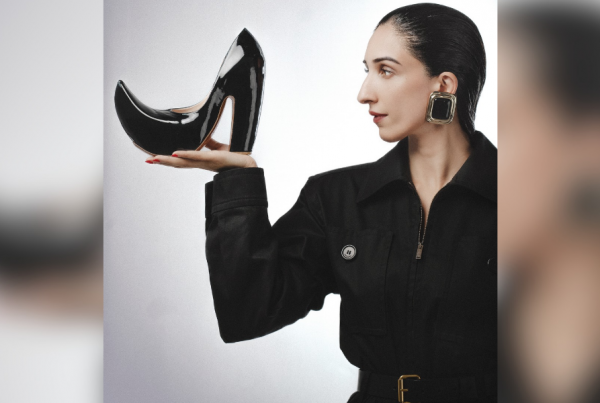Creating one dynamic collection after the other, Adnan Pardesy proves that he has what it takes to own the title.
Four well-appraised collections are what a fashion designer needs to ‘arrive’ in the industry. With Chthonic, Opine and Coquetry (showcased at the recently held PFDC Sunsilk Fashion Week for Spring/Summer 2012), Adnan Pardesy is just one collection short of making that mark of success. But Pakistan’s industry is generous and Pardesy’s acclaim is abundant. This young designer has already arrived with maturity that one associates with his mentors Maheen Khan and Rizwan Beyg when it comes to precision and perfection of garment wizadry. His is the vision of a couturier married to the commercial steadiness of a successful brand. It’s a match made in heaven.
The thin rat-tail escaping down his short hair is the only give-away of his creative streak. There are no more indicators: no flamboyance, no visual idiosyncrasies or even trademarks that fashion designers often adapt to appear quirky. If those visual changes come with time then they will be natural and not orchestrated, as so many designers are these days. It’s evident that Pardesy is secure in his skin, his focus being hard work and his skill, not his persona.
He has won critics over with that skill. Debuting at Karachi Fashion Week (2008) with a honeycomb collection that was more visual than wearable, Pardesy quickly succeeded to the second Ensemble Show that gave him exposure to some of the biggest names in fashion. His first showing at Fashion Pakistan Week – also his first attempt to make wearable clothing – didn’t go down too well but he resurfaced gracefully with Chthonic, a couturier’s ode to the construction of the Guggenheim. The rest is history as he also ventured out to the PFDC Sunsilk Fashion Week earlier this year, making him the only designer to have shown at all credible fashion weeks in Pakistan. The Opine denim collection earned him a ticket to Pret a Porter Paris last month.
“Paris was good publicity and it helped my business here. This is how I look at it,†he was quick to put things in perspective when we met for this interview. “Foreign exposure is good for learning and implementing. Locally, lawn and shalwar kameez are the biggest markets and to be very, very honest Pakistan is the biggest market for me. I’m not looking anywhere else for business yet.â€
“And I’m not in a hurry,†he continued. “I don’t want to burn out. I want to sort one step out at a time and enjoy the process. Fashion has to be commercially viable but money is a bi-product, not purpose of fashion. If it was just about the money I would be selling wheat or yarn in the family business.â€
The family business that operates from ‘Pardesi House’ on Karachi’s Queen Road is actually a small conglomerate of companies including the Textile Overseas Corporation, which is professionally linked to all trade associations and the Chamber of Commerce. The designer feels these recommendations are “essential for business in Pakistan.â€
Adnan’s job is to create designs whereas his father and brother look into the economics of things. It’s an impressive operation, providing Adnan with the financial cushion of comfort that allows him to be creative, uninterrupted. With a family business so burgeoning, why did he opt to take the tough road to fashion?
“I always wanted to be famous,†he replies with a sheepish smile. “I wanted to be Imran Khan at the age of 7. I wanted to go into film making after A-levels. Then I wanted to go into hair, make up and styling which my dad rejected outright. I couldn’t be a model since I wasn’t good looking enough. I couldn’t be an actor because I knew I’d be a character actor and never a superstar. There was one thing that could lead me to stardom and luckily that was fashion. In August 1999 I decided I wanted to be a designer and then I devoted myself to Dior, Armani, Chanel…I already knew Valentino because I used to shop at Valentino.â€
The Asian Institute of Fashion Design gave Pardesy the technical training he needed to understand fashion. He graduated with skills par excellence and soon started interning with Maheen Khan, whom he credits with being the finest designer in Pakistan. Rizwan Beyg then mentored him to fame and nurtured Pardesy’s love for couture.
“Fashion schools give technical knowledge,†he commented about his learning. “But doing eastern clothes is not simple and schools need to teach that too. They need to add courses on the understanding of business, marketing, networking etc.â€
“Rizwan Beyg made me understand that I should be able to do everything from a gown to a gharara to a bikini. I was taught never to restrict myself. After Paris every market looks restrictive but I don’t restrict myself anymore. I can turn a vase into a dress.â€
This love for couture and self confidence have taken Adnan Pardesy down a path where he is self-absorbed and oblivious to what the world around him thinks and dictates.
“I’m not bothered with what’s happening outside Pakistan,†he says with disregard for trends and forecasts that channel millions of dollars globally. “I’ve stopped buying magazines and following trends. I design what inspires me and I don’t care what anyone else is doing. My strategy is to create impractical excitement on the runway and then turn it into wearable clothes for retail.â€
This strategy has worked for Pardesy, as he is perhaps the only designer in Pakistan whose collections are ‘bought’ as opposed to ‘stocked’. Two months ago Asad Tareen of The Designers invested in Pardesy’s line of ready to wear clothing and bought 35 pieces as a test run. Successful, he repeated the order, building it up to 80 pieces on a quarterly basis.
“I know people have been critical of the inaccessibility of my label,†Pardesy explained, “but why should I make clothes and block them in stores when I can make samples with the same money and make much more profit on them from my studio? There has to be investment in fashion and The Designers offered that investment to me. That’s the way it should be done.â€
“I’m not stocking anywhere else and I’m in no hurry to. I have to get the production fluid for one outlet before I expand to the next shop, let alone another city or Dubai.â€
Adnan Pardesy is complacent, with almost no sense of competition or insecurity that shrouds most of the fashion industry. His confidence comes from personal grounding; family is important to him and family is as distant from the dazzling world of fashion as can possibly be. He admits that he owes his success to the grace of God and his parents, simple people who stayed up and helped him every night when a project was due at school.
“I was the only boy in a class of sixteen girls,†he smiles as he remembers his student years. “It initially wasn’t easy for my father to accept this but he saw my passion and dedication and finally relented. My mother hired a seamstress so I could practice cutting at home and Baba would drive me to work and wait when I was interning at Maheen’s. I’ve been very lucky that way.â€
With work and family as top priorities, today Pardesy has no time or desire to be part of the juggernaut that many people use to climb up the social ladder. “I’d rather hang out with non-fashion people in my free time,†he says.
And how does he see he industry maturing with time?
“The way I see it, in ten years time lawn will turn into ready to wear and tailors will be absorbed by the fashion industry,†he predicts. “We have just started to mature and most of us are in a mad rush to get everything done quickly. I say let’s take our time. Why hurry?â€

















